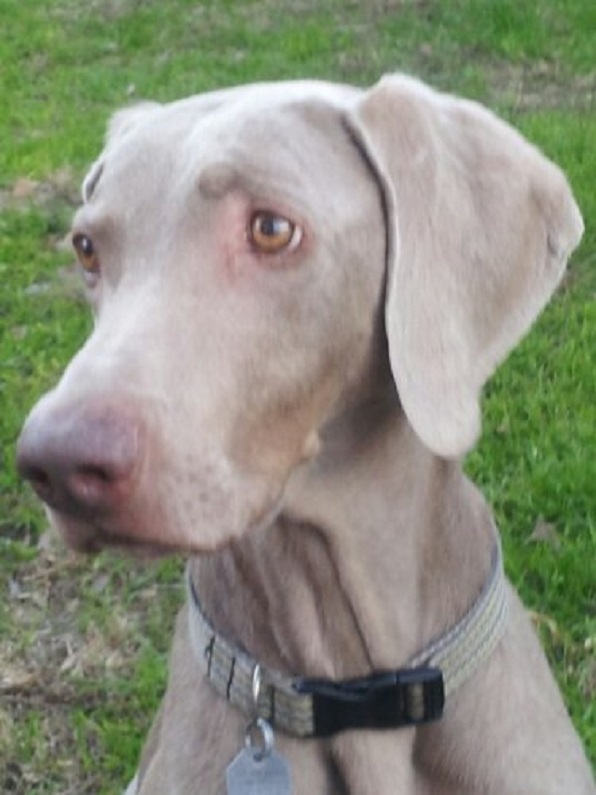
Baron the Agoraphobic Weimaraner.
I’ve recently finished the fourth period of time for the fourth “unadoptable” Weimaraners I’ve had the privilege to fostercare from Friends for Pets, southern California’s Weimaraner rescue and no-kill shelter. The first three were Paddington, Weimy and Beamer. This fellow is Baron, the dichotomous agoraphobic Weim.
Inside the house, he’s sweet, gentle, and seems to nearly be humming with blissful peace. Baron is astoundingly well-behaved, polite to anyone and all who enter it. I don’t think he’s even capable of experiencing separation anxiety, even when left alone for several hours.

) What’s that in the woodpile?
Even more startling was how easily he adapted to a new place to call home, even for relatively brief periods of about two weeks at a time.
Within the first few minutes of the first day of our first period of foster-care, Baron slipped naturally over the front door’s threshold into the house.
He entered without hesitation, sniffed about a bit, drank some of the fresh, cold water waiting for him in the kitchen and settled himself into the living room’s old blue chaise lounge armchair of the Late, Great One, Saint King Yeager the Weimaraner Himself.
(In fact, although one can often find many similarities among dogs of the same breed, Baron strikes not only me but several others as especially mirroring many gestures which characterized Yeager. They are, in fact, likely related, both having come from the Riverside, California area where there are several Weimaraner breeders, although its a very distant connection, an age different of over a decade and at least five generations.)

Scoping out that fluttering leaf.
To see Baron outside, in the long back garden, gives one’s heart a lift. Weimaraners are considered the all-in-one of the hunting dogs: they point, seize and retrieve small prey. The moment Baron hears a bird or squirrel stir, his arm and foot go up in pointer mode, and he freezes in place, performing the most purposeful call to duty for a Weim so seriously that one not dare smile or chuckle while they’re working. And then, he is art in motion, moving with breathtaking grace, leaping into and sailing through the air, covering some seven or so feet in one bound. Not even my Almighty Yeager has this sort of agility.
Was Baron once trained as a hunting dog or for agility competitions? Judging by his behavior in the yard, both scenarios seem possible.
To maintain optimum emotional and physical health, Weimaraners need to run and walk – hours each day, ideally. No matter how long my back garden may be or how many bushes and woodpiles there are for him there to explore and enjoy, it is ultimately contained, a seven-foot wood fence surrounding its entire perimeter. In the long-term its no more than a commodious prisonyard for a Weimaraner, beginning and ending with the back door leading out to it.

Squirrel-focused.
The problems begin when he walks out of the house through the front door to the larger, outdoor world.
That’s when Baron von Jekyll transforms into Baron von Hyde.
The dichotomy is only deepened by the fact that, just inside the front door, he’s eager to go out, unhesitant in having his leash attached to his chain collar – yet the first second he is on the other side of the door, his excitement converts to anxiety.
Baron doesn’t need the scent of another dog, the sound of a truck’s shrill brakes, the sight of a person walking or a leaf falling or a local newspaper sitting on the front lawn to kick into a red-alert state of extreme fear.
The moment he is outside, aware that there’s no backyard fence in this wide expanse of open sky above and endless blocks of grassy lawns and sidewalks, his tail shoots stiff and straight as a flagpole, the entire length of his back hair fully bristling up, engulfed in an anxious state of full-throttle terror.
To walk Baron is to witness his internal conflict at work. No sooner will he indulge his natural dog instinct to explore and mark than his defensive fear against nothing kick in. He’ll even freeze in place with his leg raised and stop his pee mid-stream to suddenly twist and turn his head, worriedly looking behind, in front, to the left an to the right of him.
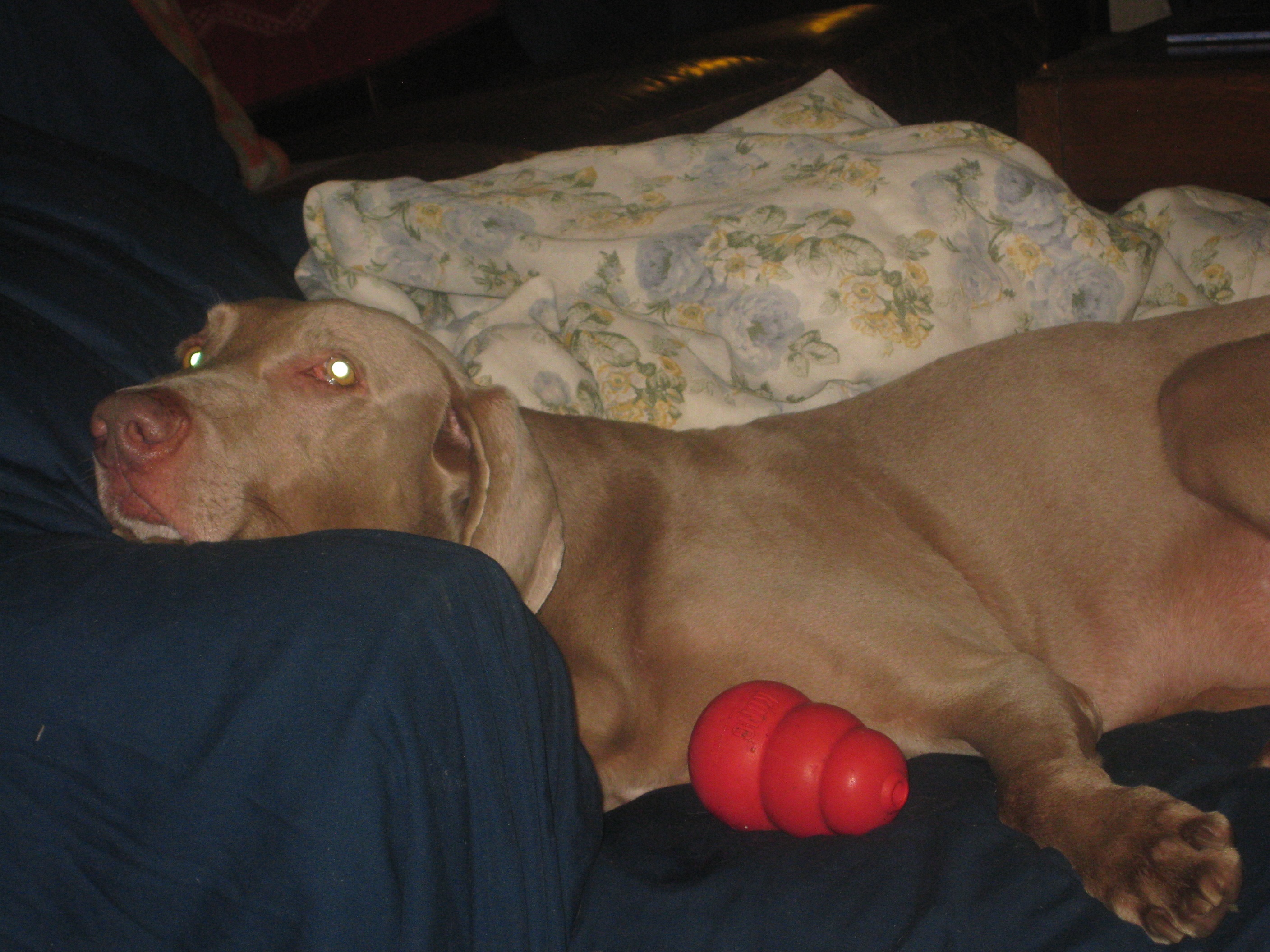
With no further treats to be found in his Kong toy, Baron finds it purposeless.
Surely, he is convinced, there’s some dog or cat around the corner just waiting to attack him. He’ll show that plastic bag flying down the street that it can’t intimidate him! He’s convinced that rosebush moved and growled, and he’ll go into pointer mode, ready to seize it by the throat if it comes closer!
During a recent, first session with animal behavioralist Jacqueline Gaillard of Blues Moon Dog Training, Baron’s dichotomy substantially reduced under the spell of distraction, specifically a game she calls “find it,” where a little bit of biscuit is tossed ahead of his path and he focuses on finding it.
But that’s just Stage One.
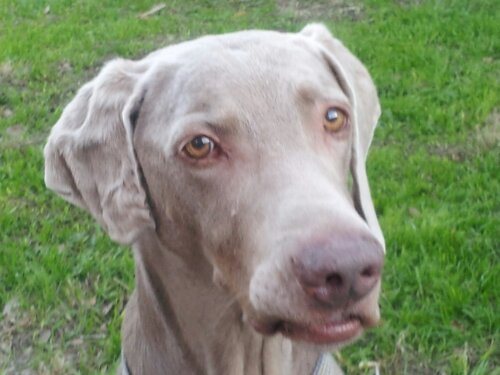
A fellow with focus – sometimes.
Stage Two starts when Baron sees, scents or hears some real being, a distant person, cat or dog, regardless of whether they’re approaching or passing in the other direction across the street. That’s when the intense barking starts and he begins to yank the leash, determined to run right up to whatever is moving.
By the randomness of great luck, almost all those people who’ve had to pass by us have been very understanding and allowed me to reach out my hand to them. The moment I do this, Baron’s ferocity vanishes and he comes up to nuzzle them, his tail wagging.
As Jackie Gaillard teaches, the moment Baron begins to react when he first senses a moving being, a sharp jerk on his chain and a pleasant but firm “unh-unh” (instead of the more negative “no”) has shown some signs of success in correcting this.

Baron’s interest engaged.
The seemingly unsolvable problem is when Baron meets another dog. And that is most definitely Stage Three.
Nothing – not a bit of a biscuit or five whole ones, not a clicker, not a whistle – will override Baron’s being consumed into state of Almighty Hell. He barks, he gnashes his teeth, he yanks and pulls and even takes a second to try biting his leash. He can focus only on that other dog; everything else he might otherwise see, hear or sense just blacks out.
As Baron the Berserk, not even a special harness which goes beneath his front legs and can stop him from running forward will force him to reconsider his reaction. Rather it provokes him into a sight both fascinating and frightening, where he literally stand up on his hind legs to his full-length of about six feet tall, as if he’s confronting a grizzly bear.
Right now, the only way to handle this is simply turn in the other direction and strongly pull him away fast. No matter how carefully he might be held, allowing Baron near another dog in an initial “exposure therapy” effort to begin reducing his fear is not yet an option.
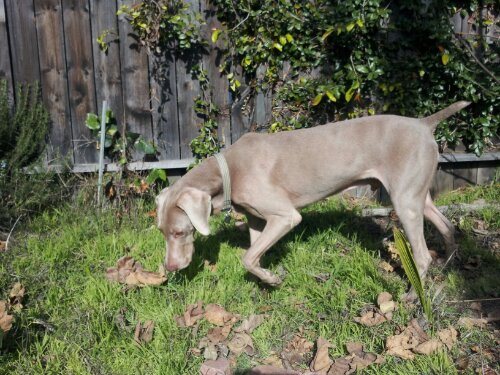
Following his instincts with a bit more calm in the yard.
In fact, within the first hour of our first foster-caring period last October, when I stopped to get a coffee at my regular spot, Peet’s on Larchmont Boulevard, we came upon a famously gentle, even docile Husky named Zero. Baron went instantly berserk – and Zero gave him a bit on the face. That was that, I immediately determined. In foster-caring Baron, I was also responsible for his safety and the prevention of him potentially harming a person or another dog. There could be no more close encounters with other dogs.
The next day, I took him to Pan-Pacific Park, headed for the baseball field which was entirely enclosed by a high fence with a door that latched closed. Hurrying him past the few dogs and their human companions that were there on a late morning weekday, Baron started freaking at the distant sight of a Golden Retriever being held on leash by one of those underfed actress-models on a cellphone, which are ubiquitous in Lost Angeles. While chatting on her phone she and her dog began to approach me and Baron – until I put my hand up fast to stop her, jerking it back and forth, signaling her to stay away. Breaking into giggles on her phone, she stayed put.
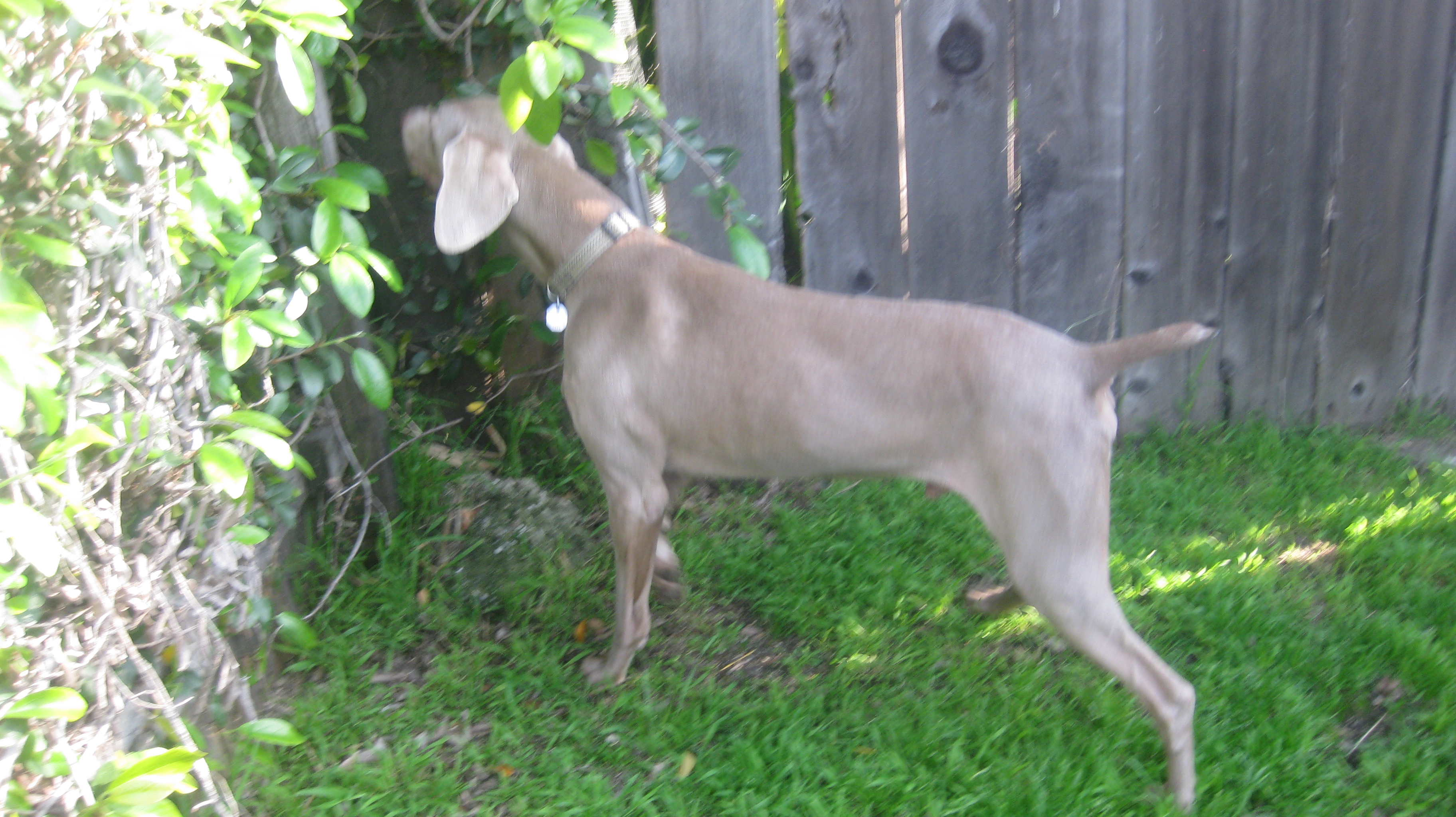
The cat that got away.
Meanwhile, I got Baron into the baseball field, and latched the fence door shut. Safely away from all other dogs or distractions, I dropped the leash and then witnessed a beautiful, unexpected sight. For but a few seconds, Baron seemed uncertain about what he was now allowed to do. Then, instinct took over and he ran. He ran as if he’d never been allowed to run so freely.
Twice, Baron stopped in his tracks, looked up to me, and let out a happy whimper. And then he just kept running, back and forth from one end of the fenced field to the other. He stopped a third time.
This time, his back tail went straight up. He sailed through the sky more fluidly than he could in the back garden, having a further length of space to run. He flew right past me – and straight to the Golden Retriever and dopey Stick-Girl who had unlatched the gate door and come into the enclosed ball-field.

Two bites from two dogs in the first two days, but Baron has healed completely and without scarring.
Whether she had mistaken my jerking hand gesture to keep away to instead be a friendly wave quickly became a moot question as Baron and her Golden Retriever “engaged.”
Luckily, I hadn’t removed Baron’s leash but simply dropped it – allowing me to step on it and stop the frightening fight, but not before the Golden had left his teeth marks in Baron’s forehead.
Stick-Girl grabbed hold of the Golden and wisely made a rapid retreat with him out of the enclosed field.
Twenty-four hours after starting our first foster-caring period together, Baron and I sat in a vet’s office, waiting for his wounds to be treated. Luckily, the bites were minor and there were no permanent scars. At least, physical ones.
What makes Baron so dichotomous and agoraphobic? Why the onset of such intense “fear aggression” at the mere whiff of another dog – yet such immediate gentleness with people, even outside the home, once he’s shown they’re not harmful? What provoked two dogs not to wait to see if his bark was worse than his bite? How could a dog be so astoundingly responsive to even a barely-audible command inside the door – yet not even hear a loud reprimand when he’s on the other side of it?

Baron is ready for breakfast.
There’s a few emerging clues – but no definitive answers.
When Baron is living in his fenced enclosure at the Friends for Pets rescue, he shows no “fear aggression” among those dogs who live behind and beside him, not an uncommon type of “survival mode” behaviors shown by dogs. His defensive ferocity surely appears to be fear because, as Jackie Gaillard detected in his voice, just beneath his barking Baron also emits a whimpering “cry.” Could such defensive ferocity be the result of living an earlier life completely unexposed to other dogs – and thus more a matter of bewilderment and perhaps even an urge to play yet not knowing how?
Who knows. He was found wandering the streets of Riverside County and brought to the county animal control center, or what used to be called the dog pound. Friends for Pets was alerted by the pound that they had a Weim scheduled to be killed the next day, simply for existing. A volunteer drove out to buy his freedom and transported him to the rescue.
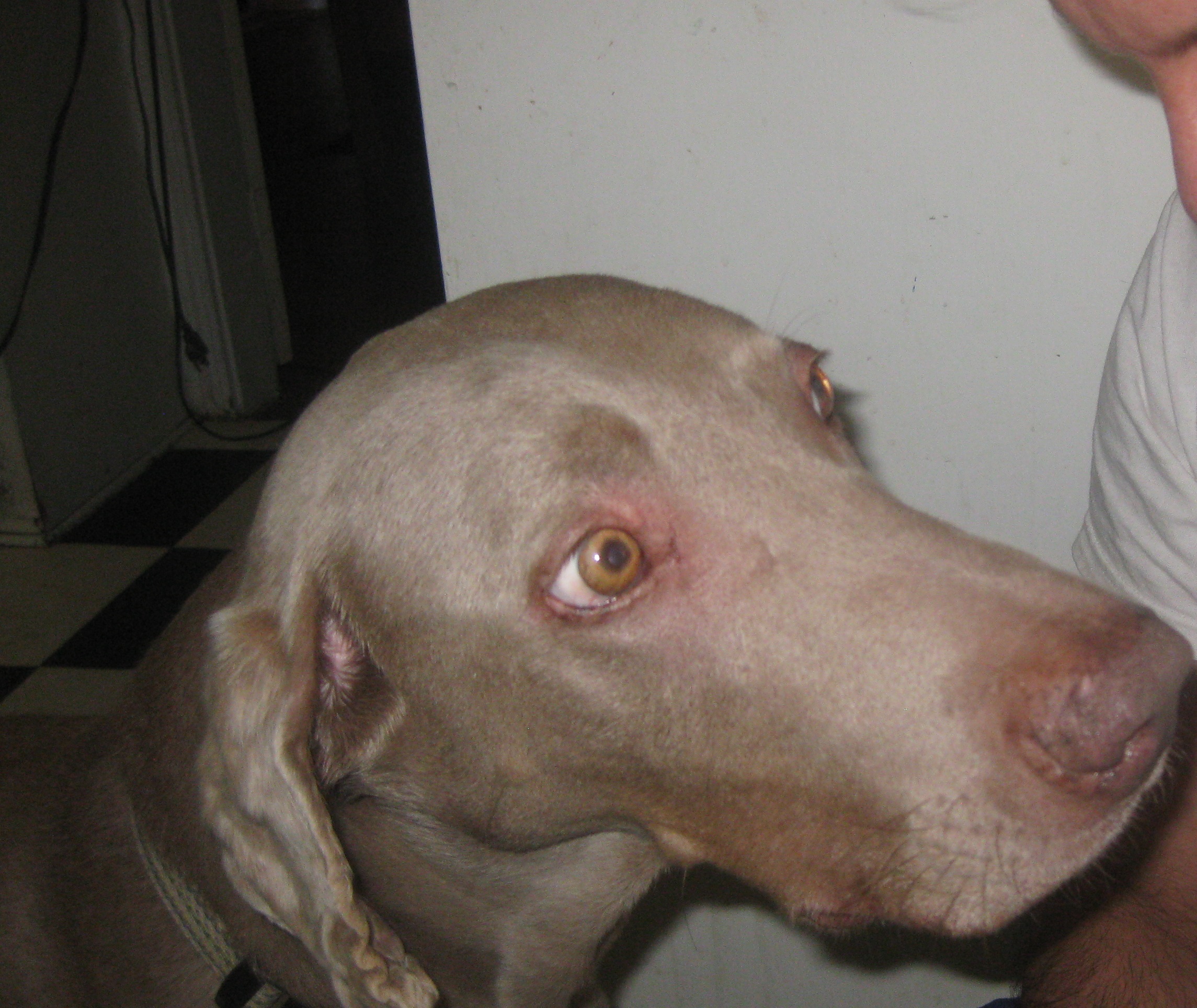
Baron’s backstory is a mystery to all but him.
His age is unknown. His initial name is unknown. The vet I brought him to for his bites guessed that he’s about five based on his eyes and teeth. He was given the name of Baron at the Friends for Pets rescue and I’ve tried to help try establish it for him.
All that’s known for sure are two dichotomous facts. He’s extremely well-trained, housebroken, attentive and eager to give you a shake of his paw, a sign that, at some point, he’d come from a loving home where he was cared for.
The sadder fact is that the pads of his paws are completely smooth, lacking any calluses, proving that for some unknown reason his most basic needs as a Weimaraner were ignored, neglected and denied him.
Perhaps his fear of being outside is the result of never having been previously walked. Perhaps he was such an excitable puppy when he was initially walked that it exasperated his initial human companion who decided not to continue walking him and train him only for indoor living. That remarkable discipline he shows indoors did not come naturally: someone committed to training him this way. It can’t be the fresh air that freaks him, since he’s fine if the outdoor space is confined by a fence. He may have once been the dog companion to an elderly person or someone unable or unwilling to get outside much. Perhaps Baron developed agoraphobia because his human companion had agoraphobia.

Baron, thinking it over.
Yet even if he had been forced to once live a sequestered life, he very much evidences a longing to be outside, in line with natural instinct. Even when he’s in the enclosed garden, Baron’s ears are perked and his tail halfway up, always on the hunt for something. He’s excited. He’s engaged. He’s happy. Tthat’s natural for a curious Weimaraner.
Why the reaction to other dogs? He may have been used as a “bait” dog, those meant to irritate and enrage “pit bulls” by ignoramuses who train American Stafffordshire Terriers to fight and kill each other as a way of making money for themselves.
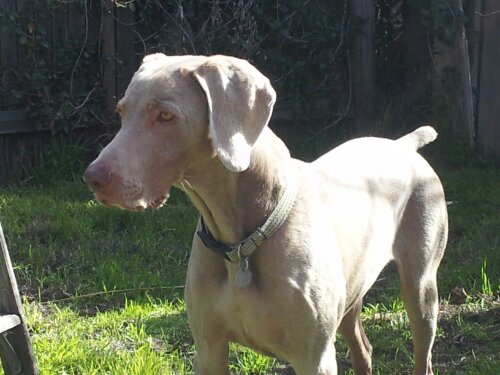
Baron at ease.
At a certain point, all these questions are moot.
For a dog breed that needs to run and be outdoors to live as healthily and happily as possible, Baron’s phobia is not just an obstacle to his long-term well-being but his being adopted. He needs to enjoy a walk without feeling compelled to lunge with force at a piece of wood.
Baron won’t change overnight, but we’ve begun the process of trying to make at least his walks around the block less stressful. On the last day of this fourth foster-caring period, there was the slightest sign of success. His indoor discipline suggests there is hope he can learn to behave differently outside. He’s got the energy and excitement and joy of an older puppy. He is far too young and intelligent and happy to write off as a dog doomed to live out his life largely inside.
As I did with the three previous Weimaraners I’ve previously foster-cared, I have naturally come to love Baron. Part of truly coming to care for him, however, also means recognizing one’s own limitations at a given time, and not indulging the fantasy of adopting him or becoming sullen over the fact that one can’t.
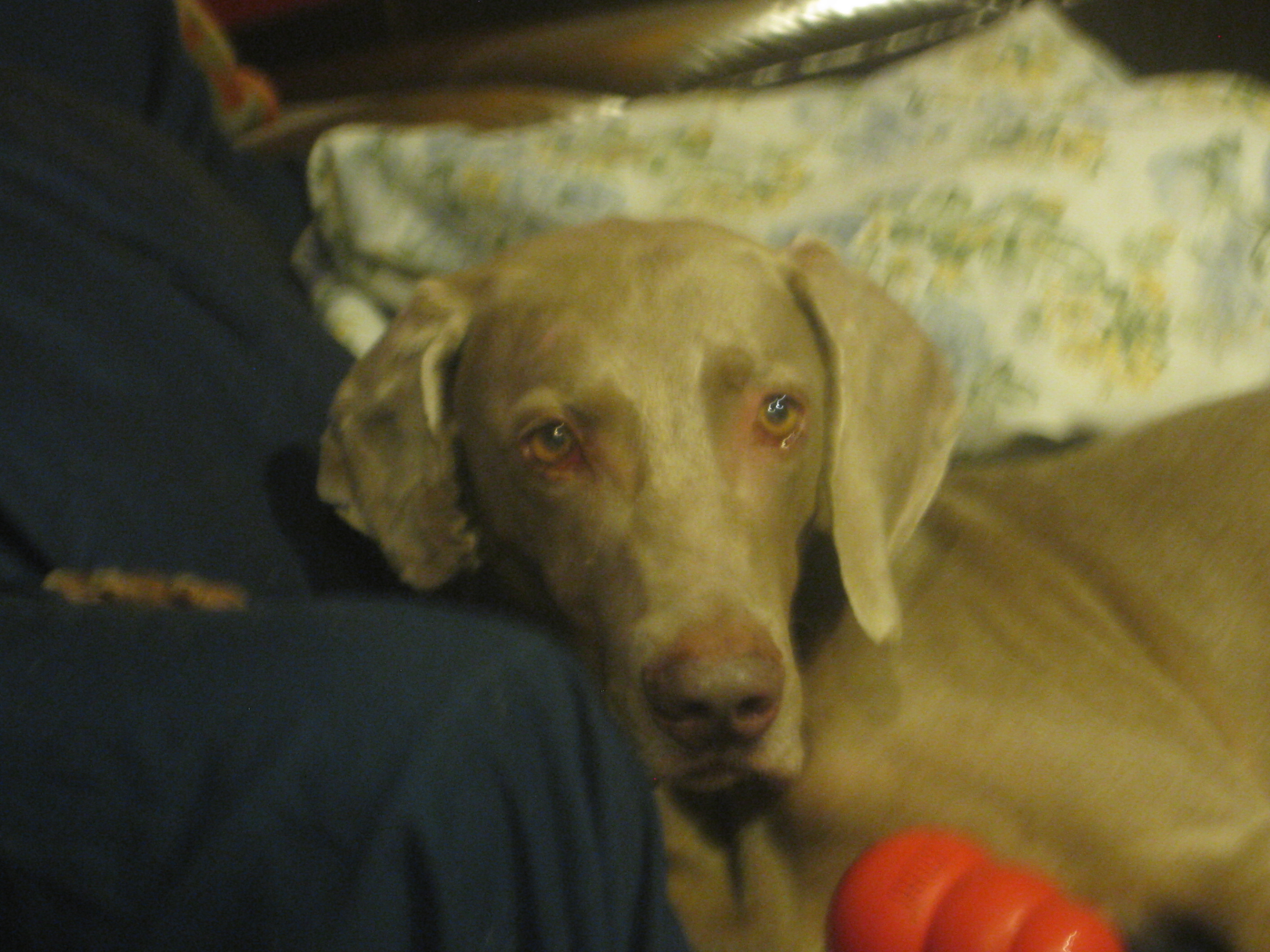
Baron’s right ear had a hemotoma which was medically treated, further suggestion he once shared his life with a caring human.
Unlike many situations where someone cares for a dog until a permanent home can be found for them, the Weims from Friends for Pets are especially blessed to always have a permanent home at the rescue, where their health and protection are paramount. In Baron’s case, we’ve developed a careful pattern which has resulted in an ease of normality when I return him there, in between our periods together. At the shelter, Baron eats and sleeps without depression or any sense of abandonment.
Foster-caring dogs is not a sly way of adopting them. With their own unique sets of issues and needs, these living beings are not supposed to be simply placed at the disposal of indecisive humans, who first want to “test” or “try out” a dog by using the excuse of foster-care. It can be the crucial period which helps to make a dog “adoptable” by the human who recognizes that such a commitment is intended for the dog’s lifetime and will entail continuing the training begun during the period of foster-care.
The foster-caring process provides incredible personal satisfaction for the human but its purpose is always to help the dog. Its ultimate goal is to help make them adoptable by those who are fully prepared to make that commitment to them. I am committed on my end, to help Baron narrow his dichotomy and reduce his agoraphobia so that he can spend every one of his days enjoying what is simply his most fundamental right.
Being a dog.

Gentle Baron patiently waits.
Related articles
- Goggie ob teh Week: Royal Hunter (cheezburger.com)
- Animal Portraits – Peppy x 2 – Watercolour Pet Portrait (carentaylor.wordpress.com)
- Lulu’s Story – A Dog Unfairly Murdered by the British Columbia S.P.C.A. (thehappypitbull.wordpress.com)
- Would You Vote For This Dog? (lasvegas.cbslocal.com)
- MOCAtv: William Wegman & his Weimaraner Dogs (kcet.org)
Categories: Dogs, Foster Caring Dogs
Tags: Baron, Friends For Pets, Weimaraner
 Long-Ago Dogs & Their Devoted Companions: The Days of the Dogs
Long-Ago Dogs & Their Devoted Companions: The Days of the Dogs 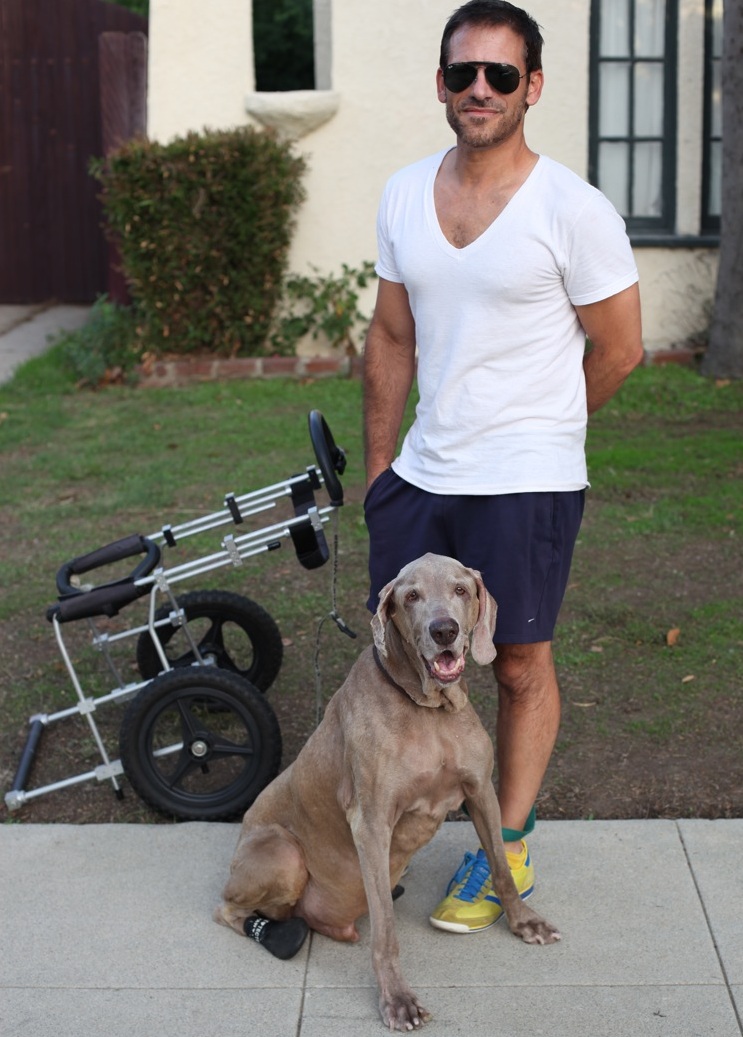 Helping A Very Old Dog Live Well & Naturally: A Two-Part Series
Helping A Very Old Dog Live Well & Naturally: A Two-Part Series  Never Forgetting A Dog’s Birthday
Never Forgetting A Dog’s Birthday  Fostercaring Dogs: An Often Ignored but Crucial Role in Saving Lives (Part 1)
Fostercaring Dogs: An Often Ignored but Crucial Role in Saving Lives (Part 1)  How A New Dog Brought An Old Dog Home
How A New Dog Brought An Old Dog Home  Changing a Dog’s Name: How Caesar Became Hudson
Changing a Dog’s Name: How Caesar Became Hudson
Dear Carl,
I have to say — WOW, you are a saint. What a great owner you are, and what great and patient care you take of all of your dogs… my sister has a Weimeranar — they are terrific dogs, but they definitely need lots of physical activity!
Baron is lucky to have you in his corner. Thanks for keeping all of us posted.
xox Pamela
Pamela – double wow back at you for saying that – and hardly a saint because except for those stressful walks, I’m really the one getting the great benefit of Baron’s company. As all writers know, it is such a solitary existence when one is working (and it seems one is always working, because if you’re not typing it out, you’re thinking it through) and the companionship of a dog is so steadying and pure. And all they really want is love – and that’s one thing which costs nothing and can’t be taxed. So one can’t help but really want to help Baron – or any dog in need. And at the end of the day, it really is helping dogs in need, one by one. I can’t put into words really how rich an experience foster-caring has emerged as being. Thank you for some really encouraging and supportive words – and so maybe I will chronicle, continue to update on good ole Baron.
Baron is so beautiful and adorable! What a great face and eyes! I am sure that you and Dr. Gaillard will help alleviate his defensive behavior. Baron deserves a happy, normal dog life. Thank you for helping these wonderful best friends!
You’re really kind – and its great to see we’ve got a few mutual interests – thank you for your remarks. And I do sure hope the day will come when he can be placed in a forever home.
Carl, Baron is very lucky to have you there for him. I have said it before but will again….you have a beautiful heart and such empathy in writing about these things. Would love to be updated, too, on sweet Baron’s progress. He is beautiful….
Thank you Beth – but the truth is I am but one among a force of others, like yourself, who have detected the acutely sensitive and trusting nature of these beings we call dogs and feel compelled to help make up for what other people were unable or unwilling to do on their behalf. There are so many stories about people – with busy, strictly 9-to-5 jobs, or children to care for, or living their own lives with various limitations – who feel likewise and volunteer their time and give their entire focus to the many, many aspects of dog rescue work. Baron is a beautiful, gentle soul – cracking his terror is really a challenge, but I am committed to doing my best to help him. Yes, I will provide updated articles on him down the road – but for now, thank you for taking the trouble to sign onto WordPress and the time to write.
Hey Carl–
I guess I missed this post when you wrote it in March. It’s beautiful. I’m a rescue dad of two Corgis so I know about dogs with unknown issues in their pasts. Thanks for doing what you do. Just wanted to see if you had a moment to update us on Baron. Are you still fostering him? Peace to both of you–
Sam
BTW–Were you in Dallas for the Bush Library opening by any chance?
Well, I’ve been traveling quite extensively so I have not had Baron. Currently, we’re seeking advise from a seasoned trainer; his behavior is so peculiarly split. Was not at the Bush Library dedication.
Carl,
While perusing the website, I was thrilled to see “Dogs” as one of the subjects. I volunteer for PAWS (Philadelphia Animal Welfare Society), the largest no kill shelter in the city. I have a rescue dog (Snickers) who isn’t good with other dogs, which is probably a good thing, as I would most likely adopt a herd of dogs! Since I cannot adopt another, I take the shelter dogs to events, wearing their “Adopt Me” vests, and introduce them to the public, and possibly a potential adopter.
Kudos to you for fostering, although as an animal lover, I know that you get as much joy from fostering as the dog gets from being in a home. And the time in foster care is so crucial, especially if, like in Barons situation, there are behavioral issues, or if there are medical needs to be addressed.
Are you familiar with The Gentle Barn? It is outside of LA, a non-profit that rescues a variety of animals, from chickens to horses (and some dogs & cats in the mix as well). Their story is wonderful, if you have a chance, take a look at their website. I’m looking forward to visiting them on my next trip to LA (my sister lives at the base of Eagle Rock on the outskirts of Pasadena). I hope you enjoy their story as much as I did.
I hope Baron finds the forever home that he deserves. In the meantime, thank you for all you are doing for him!
Sincerely,
Clare S.
Philadelphia PA
The longer I live the more deeply I value the dignity, the intelligence and the wisdom of all animals…with a decided preference for Dogs. And the more I am willing to be public about it, the greater numbers of people I find who share the same values of respect for dogs and the urge to protect them. It is hard for me to accept that Baron may always be an “inside” dog, so to speak but I will always give him a foster home in the hopes that somehow it helps him. The good news is that, like those organizations you mention, Friends for Pets, the Weimaraner (and other dogs) rescue of southern California will always given Baron and many others a permanent, safe and loving place to live out their lives if they never find a forever home. And thank you for telling me about the Gentle Barn – you can count on me looking into them and hopefully making a visit sooner rather than later. Thank you for writing – and understanding and for doing your work too. I recently read something which crystallizes the argument against what can often seem overwhelming and futile: “Saving one dog’s life may not save the word, but it is the world to that dog.”